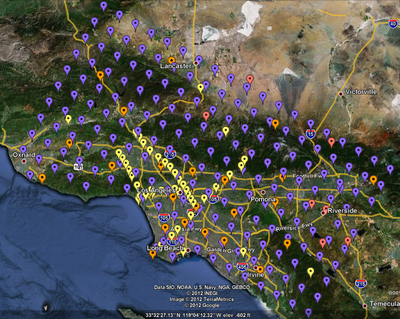Difference between revisions of "CyberShake Study 2.2"
| (17 intermediate revisions by 3 users not shown) | |||
| Line 1: | Line 1: | ||
CyberShake Study 2.2 is a proposed study to calculate hazard curves under [[CyberShake 1.1]] using CVM-S and the Graves and Pitarka (2010) rupture variations. We are reusing previously computed SGTs, so only the post-processing needs to be calculated. The goal is to calculate the same site list as for CyberShake 1.0 so we can produce comparison curves and maps. | CyberShake Study 2.2 is a proposed study to calculate hazard curves under [[CyberShake 1.1]] using CVM-S and the Graves and Pitarka (2010) rupture variations. We are reusing previously computed SGTs, so only the post-processing needs to be calculated. The goal is to calculate the same site list as for CyberShake 1.0 so we can produce comparison curves and maps. | ||
| − | == | + | == CyberShake 2.2 Hazard Model Results == |
| + | Data products are available [[Study 2.2 Data Products|here]]. | ||
| − | + | *[https://scec.usc.edu/it/CyberShake CyberShake Internal Wiki] | |
| − | We began | + | The SQLite database for this study is available at /home/scec-04/tera3d/CyberShake/sqlite_studies/study_2_2/study_2_2.sqlite . It can be accessed using a SQLite client. |
| − | Runs were paused on October 16 when we used all available SUs on Kraken. | + | |
| − | Runs were resumed on November 8. | + | Curves calculated with CyberShake Study 2.2 use Hazard Dataset ID 12. |
| + | |||
| + | == Current Simulation Status == | ||
| + | |||
| + | 47 sites were completed before beginning the October 2012 production runs. We began Study 2.2 on October 8, 2012. Runs were paused on October 16 when we used all available SUs on Kraken. Runs were resumed on November 8 and this production simulation was completed on 6 March 2013. | ||
{| border="1" cellpadding="4" | {| border="1" cellpadding="4" | ||
| − | !colspan="2" | Updated: | + | !colspan="2" | Updated: 3/6/13 |
|- | |- | ||
| − | |Sites complete: || | + | |Sites complete: || 217 |
|- | |- | ||
| − | |Sites remaining: || | + | |Sites remaining: || 0 |
|} | |} | ||
| Line 37: | Line 42: | ||
The computational science review slides are available [[Media:Computational_Review.ppt| here]]. | The computational science review slides are available [[Media:Computational_Review.ppt| here]]. | ||
| + | |||
== Related Entries == | == Related Entries == | ||
| − | + | *[[CyberShake]] | |
| − | *[[ | + | *[[CyberShake Study 2.3]] |
Latest revision as of 16:43, 6 February 2018
CyberShake Study 2.2 is a proposed study to calculate hazard curves under CyberShake 1.1 using CVM-S and the Graves and Pitarka (2010) rupture variations. We are reusing previously computed SGTs, so only the post-processing needs to be calculated. The goal is to calculate the same site list as for CyberShake 1.0 so we can produce comparison curves and maps.
Contents
CyberShake 2.2 Hazard Model Results
Data products are available here.
The SQLite database for this study is available at /home/scec-04/tera3d/CyberShake/sqlite_studies/study_2_2/study_2_2.sqlite . It can be accessed using a SQLite client.
Curves calculated with CyberShake Study 2.2 use Hazard Dataset ID 12.
Current Simulation Status
47 sites were completed before beginning the October 2012 production runs. We began Study 2.2 on October 8, 2012. Runs were paused on October 16 when we used all available SUs on Kraken. Runs were resumed on November 8 and this production simulation was completed on 6 March 2013.
| Updated: 3/6/13 | |
|---|---|
| Sites complete: | 217 |
| Sites remaining: | 0 |
Sites
We have identified 268 sites to calculate, of which 45 are sites of interest, 25 are additional basin sites, 190 are 10 km gridded sites, and 8 are precarious rock sites. A spreadsheet with a list of these stations and their locations is available here.
Computational estimates
We are planning to use Kraken to perform this study. We estimate the following resource requirements:
1.2M SUs
2.5 TB SCEC storage
3300 zip files, containing 232M seismogram and PSA files
Additional Information
The science review slides are available here.
The computational science review slides are available here.
